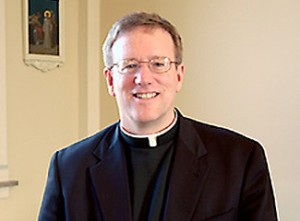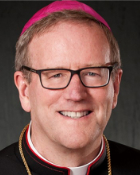[ Three years] ago I began posting brief reflections on movies, music and culture on YouTube, probably the most watched Web site in the world. This exercise has resembled St. Paul’s venture onto the Areopagus in Athens, preaching the Gospel amid a jumble of competing ideas. YouTube is a virtual Areopagus, where every viewpoint-from the sublime to the deeply disturbing-is on display. Never as a Catholic teacher or preacher have I addressed less of the “choir.” The most numerous responses have come to my pieces on atheism and belief. I have made a video called “Why It Makes Sense to Believe in God,” three others answering Christopher Hitchens and, the most popular, a response to Bill Maher’s film “Religulous.”
Three years] ago I began posting brief reflections on movies, music and culture on YouTube, probably the most watched Web site in the world. This exercise has resembled St. Paul’s venture onto the Areopagus in Athens, preaching the Gospel amid a jumble of competing ideas. YouTube is a virtual Areopagus, where every viewpoint-from the sublime to the deeply disturbing-is on display. Never as a Catholic teacher or preacher have I addressed less of the “choir.” The most numerous responses have come to my pieces on atheism and belief. I have made a video called “Why It Makes Sense to Believe in God,” three others answering Christopher Hitchens and, the most popular, a response to Bill Maher’s film “Religulous.”
YouTube viewers can post comments the hundreds I’ve received have been overwhelmingly negative. Some are emotionally driven and rude, but others are thoughtful and have given rise to serious exchanges. As I debate with these mostly young opponents of religion, and Catholicism in particular, I have discerned four basic patterns of opposition that block the reception of the faith. In the second century, St. Irenaeus wrote his classic Adversus Haereses (Against the Heresies) if a contemporary apologist would like to know the heresies of our time, she might consult these YouTube objections. I have identified four: scientism, ecclesial angelism, biblical fundamentalism and Marcionism.
Scientism. In the videos, I have appealed to classical and contemporary arguments for the existence of God, demonstrating that there must be a stable ground for the contingency of the world and an intelligent source for the intelligibility of the world. I am met with some version of the following assertion: Matter, or the universe as a totality, or the big bang, or “energy” is an adequate explanation of all that is. When I counter that the big bang is itself the clearest indication that the entire universe – including matter and energy – radically contingent and in need of a cause extrinsic to itself, they say that I am speaking nonsense, that science gives no evidence of God’s existence. I agree, insisting that the sciences deal with realities and relationships within the world but that the Creator is, by definition, not an ingredient in the world he made.
What I am up against here is not science, but the philosophical position that reality is restricted to what the empirical sciences can measure. When one of my opponents asserted that science alone deals with reality, I informed him that he was involved in an operational self-contradiction, for he was making an unscientific remark in support of his claim. I am struck by how philosophically impoverished my YouTube interlocutors are. Though many can speak rather ably of physics or chemistry or astronomy, they are at a loss when the mode of analysis turns philosophical or metaphysical.
The second heresy I call ecclesial angelism. Repeatedly my conversation partners say: “Who are you, a Catholic priest, to be making truth claims, when your church has been guilty of so many moral outrages against the human race: the Crusades, the Inquisition, witch hunts, support of slavery and the clerical sex abuse scandal?” My arguments in favor of religious belief are not so much refuted as ignored, with a “consider the source” wave of the hand.
I respond by insisting that the existence of bad Catholics does not in itself demonstrate that Catholicism is a bad thing. A rare ally on a YouTube forum observed that the use of Einsteinian physics in the production of the nuclear weapons that killed hundreds of thousands of innocents does not amount to an argument against Einstein. As the old dictum has it, bad practice does not preclude good practice.
I do not deny the major premise of their argument. I’ve told them I stand with John Paul II, who spent years apologizing for the misbehavior of Catholics over the centuries. But Christians have known always that the church, as Paul put it, “holds a treasure in earthen vessels.” In its sacraments, especially the Eucharist, in its essential teachings, in its liturgy and in the lives of its saints, the church participates in the very holiness of God. But in its human dimension, it is fragile. Ecclesial angelism blurs this distinction and allows any fault of church people to undermine the church’s claim to speak the truth.
A third heresy is biblical fundamentalism. I hear from my YouTube opponents that the Bible is a mishmash of “bronze-age myths” (Christopher Hitchens) and childish nonsense about talking snakes, a 5,000-year-old universe and a man living three days inside of a fish. I observe in reply that the Bible is no so much a book as a library, made up of texts from a wide variety of genres and written at different times for varying audiences. Just as one would not take “the library” literally, one should not interpret the whole Bible with one set of lenses.
My YouTube conversation partners typically fire back that I am proposing a novelty in order to respond to the attacks of modern critics. I try to steer them to Irenaeus (second c.), Origen (third c.) and Augustine (fourth c.), all of whom dealt with the complexity of the Bible through the exercise of a deft hermeneutic. Some of those who appreciate the library analogy wonder how one would decide which kind of text one is dealing with and hence which set of interpretive lenses to wear. I respond that their good question proves the legitimacy of the Catholic Church’s assumption that the church-that variegated community of interpretation stretching over 20 centuries – required for effective biblical reading today. I ask, How do you know the difference between Winnie the Pooh, The Brothers Kara-mazov, the Divine Comedy, Carl Sandburg’s Lincoln and Gore Vidal’s Lincoln? Then I answer my own question: You have been taught by a long and disciplined tradition of interpretation. Something similar is at play in authentic biblical reading.
The fourth YouTube heresy is Marcionism, which brings us back to one of Irenaeus’s principal opponents, Marcion. He held that the New Testament represented the revelation of the true God, but that the Old Testament was the revelation of a pathetic demigod marked by pettiness, jealousy and violence. This ancient heresy reappears practically intact on the YouTube forums. My interlocutors complain about the morally offensive, vain, psychotic and violent God of the Old Testament, who commands that a ban be put on cities, who orders genocide so that his people can take possession of the Promised Land, who commands that children’s heads be dashed against stones. In the wake of the terrorist attacks on Sept. 11, 2001, this complaint becomes more pointed. If I gesture toward the wisdom of the biblical tradition, I am met with this objection.
I urge my respondents to read the entire Bible in the light of Christ crucified and risen from the dead. I tell them of an image in the Book of Revelation of a lamb standing as though slain. When no one else in the heavenly court is able to open the scroll that symbolizes all of salvation history, the lamb alone succeeds. This indicates that the nonviolent Christ, who took upon himself the sin of the world and returned in forgiving love, is the interpretive key to the Bible. It was in this light that Origen, for example, read the texts concerning the Old Testament ban as an allegory about the struggle against sin. The bottom line is this: One should never drive a wedge between the two testaments instead, one should allow Christ to be the structuring logic of the entire Scripture.
What is blocking the preaching of the faith, especially to younger people? Many things. But I would suggest that preachers, teachers, evangelists and catechists might attend with some care to these four.
Please help us in our mission to assist readers to integrate their Catholic faith, family and work. Share this article with your family and friends via email and social media. We value your comments and encourage you to leave your thoughts below. Thank you! – The Editors













